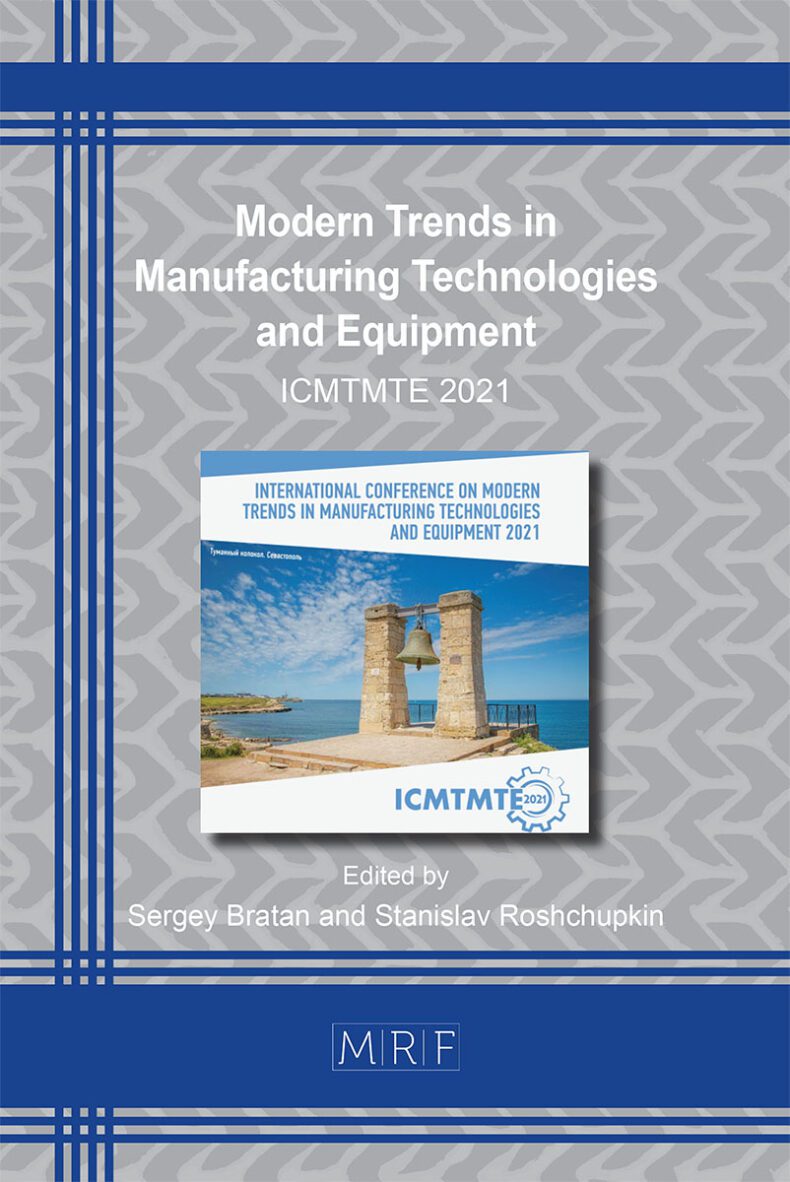Assessment of a Heterogeneous Environment
Alexander Zverovshchikov
download PDFAbstract. An approach to the assessment of a heterogeneous environment in accordance with the proposed concept of a heterogeneous environment is described. The classification of industrial heterogeneous media by technological feature is proposed. The processes described by the proposed approach include the process of metal cutting, surface plastic deformation, chemical-thermal treatment, formation of coatings, welding, most of the processes that change the level and gradient of hardness and internal stresses in the surface layer of the material. Application of the proposed principles makes it possible to find new directions in the study of such processes.
Keywords
Heterogeneous Environments, Cutting, Coating, Metal, Technologies
Published online 1/5/2022, 7 pages
Copyright © 2022 by the author(s)
Published under license by Materials Research Forum LLC., Millersville PA, USA
Citation: Alexander Zverovshchikov, Assessment of a Heterogeneous Environment, Materials Research Proceedings, Vol. 21, pp 436-442, 2022
DOI: https://doi.org/10.21741/9781644901755-72
The article was published as article 72 of the book Modern Trends in Manufacturing Technologies and Equipment
![]() Content from this work may be used under the terms of the Creative Commons Attribution 3.0 licence. Any further distribution of this work must maintain attribution to the author(s) and the title of the work, journal citation and DOI.
Content from this work may be used under the terms of the Creative Commons Attribution 3.0 licence. Any further distribution of this work must maintain attribution to the author(s) and the title of the work, journal citation and DOI.
References
[1] K Shannon, Mathematical theory of communication. «Works on Information Theory and Cybernetics, Moscow, Publishing of Foreign Literature Publishing House (1963) pp.243–332.
[2] B.A. Erznkyan, Technological and institutional development of the socio-economic system in a heterogeneous environment, JOURNAL OF INSTITUTIONAL STUDIES, Volume 4, No. 3. 2012.
[3] V.S. Igropulo, Heterogeneous environment with active components: physical system, mathematical model, real prototypes. Proceedings of Bulletin of Stavropol State University 38/2004 pp.113-116.
[4] V.I. Gorodnichenko and others, Materials Science: Workshop, Moscow – Logos Proceedings, 2003.
[5] G.I. Dulnev and V.V. Novikov, Transfer processes in heterogeneous media, Leningrad, Energoatomizdat Publishing, Leningrad Branch, 1991.
[6] Materials Science. Technology of structural materials: textbook. manual ed. B.C. Cherednichenko. – 2nd ed. – Moscow; Omega-L Publishing House, 2006.
[7] L.Barre, Kinetics of Heterogeneous Processes. – Moscow, Mir Publishing House, 1976.
[8] 8 D.A. Frank – Kamenetky, Diffusion and heat transfer in chemical kinetics, Moscow Publishing House Science, 1987.
[9] V.F. Kuropatenko, New models of continuum mechanics Engineering Physics Journal., 2011, Volume 84, No. 1. p. 74–92. https://doi.org/10.1007/s10891-011-0457-0
[10] V.F. Kuropatenko, Model of a multicomponent environment, Reports of the Academy of Sciences, 2005, Volume 403, No. 6. – p. 761–763
[11] V.Fortov, Powerful shock waves and extreme states of matter. Moscow, Bukos Publishing House, 2005. https://doi.org/10.1238/Physica.Topical.116a00007
[12] A.P. Aldushin, T.M. Martemyanova, A.G. Merzhanov, B.I. Khaikin and Shkadinsky K.G. Self-Oscillatory Propagation of a Combustion Front in Heterogeneous Condensed Matter, Journal of Combustion and Explosion Physics. 1973. Vol. 9, No. 5. p. 613-626. https://doi.org/10.1007/BF00742879
[13] V.G .Prokofiev and V.K. Smolyakov, Nonstationary regimes of combustion of a binary gasless mixture when ignited by a heated wall, Journal of Combustion and Explosion Physics. 2005.Vol. 41, No. 2. pp. 45-50. https://doi.org/10.1007/s10573-005-0018-y
[14] K.A. Aligozhin and A.G. Knyazeva, Modeling of transformation modes that are realized when joining dissimilar materials using solid-phase synthesis, Journal of Mathematical Modeling in Natural Sciences. 2013. No. 1. pp. 8-10
[15] A.Yu. Krainov and DS Shultz, Mathematical modeling of an ultrahigh-speed process in heterogeneous reacting powder mixtures, Journal of Computer Research and Modeling, 2011, Volume 3, No. 2, pp. 147-153. https://doi.org/10.20537/2076-7633-2011-3-2-147-153
[16] V.E. Fortov, Equations of state of matter: from ideal gas to quark-gluon plasma, Moscow, Fizmatlit Publishing House, 2012.
[17] R. I. Nigmatulin, Fundamentals of mechanics of heterogeneous media, Moscow, Science Publishing House. 1973.
[18] GOST R 52381-2005 Abrasive materials grain size and grain size composition of grinding powders. Grain composition control.
[19] V. M. Markochev and M. I. Alymov, On the theory of brittle fracture by J. Frenkel and A. Griffiths, CHEBYSHEVSKY Sbornik, 2017 Volume 18 Issue 3. https://doi.org/10.22405/2226-8383-2017-18-3-381-393
[20] Vladimir A. Grachev, Andrey E. Rozen, Yury P. Perelygin, Sergey Yu. Kireev, Irina S. Los Multilayer corrosion-resistant material based on iron–carbon alloys// Heliyon 6 (2020) e04039. https://doi.org/10.1016/j.heliyon.2020.e04039































